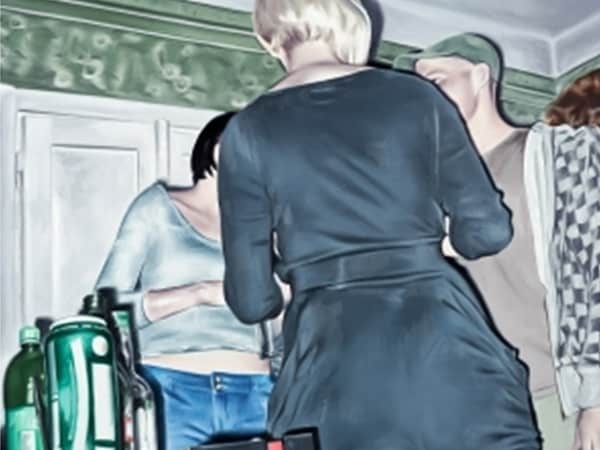An exhibition of Marcin Maciejowski’s work will be held until 2 June 2013 at Baltic – Centre for Contemporary Art located on the banks of river Tyne in Gateshead. The exhibition comprises of 25 paintings created between 2003 and 2012. It is Maciejowski’s first individual exhibition in a public institution in the United Kingdom.
Maciejowski is a painter, drawer and cartoonist. Together with Wilhelm Sasnal and Rafał Bujnowski he founded the legendary Ładnie Group, which was active between 1996 and 2001 in Krakow. Maciejowski’s works from that period, similarly as Bujnowski’s and Sasnal’s, includes a mix of scenes from everyday life and repainted pages from tabloids and women’s magazines, photographs and stills from films.

Marcin Maciejowski, Overwhelmed by the great tradition of the city which hogs, 2012 Oil on canvas 170 x 130 cm Courtesy Wilkinson Gallery, London
The Ładnie Group, submerged in myths and legends about its foundation and activity, active both artistically and socially, is considered one of the most important artistic phenomena of the end of the 20th century in Poland. The term ‘pop banalism’ was coined to capture their style. Their style’s formal characteristics are inspirations with everyday life, comic books, synthetic summary, removal of detail. Their painting was legible and comprehensible.
One of Maciejowski’s first exhibitions was „Chodze z Lidka, chodze z Ewa, chodzę z Magdą” (‘I date Lidka, I date Ewa, I date Magda’) (Krakow 1998). It was fully devoted to women – friends, shop assistants, movie stars – young beautiful girls are among Maciejowski’s favourite motifs. The Baltic Centre exhibition of his paintings is full of celebrities known from tabloids, posing for the paparazzi on the red carpet. Maciejowski cleanses his paintings from superfluous details. In this case, the superfluous detail turns out to be the faces of the movie stars. However, one may recognise for example Anne Hathaway by her figure and hairstyle. Maciejowski seems to suggest that on the one hand, maybe paradoxically, each celebrity is a creation devoid of individual characteristics, while on the other, one may easily recognise them, even without a face. This also points to the simplified vision of the world presented by tabloids, which show it devoid of the most important detail.

Marcin Maciejowski, VIP I – XII (2008). Oil on canvas (10 canvasses)© Courtesy Marcin Maciejowski and Wilkinson Gallery, London
The universal comment on pop culture makes Maciejowski’s work poignant and legible both in Poland and the UK – maybe even more so in Britain – where the cult of celebrities is well rooted.
The exhibition also shows works, the point of reference of which are images from artist’s own family archive. A characteristic example is the work called “Overwhelmed by the great tradition of the city which hogs”, painted from a clumsily taken snapshot showing a group of friends at a party.
The juxtaposition of works showing celebrities and close friends highlights the nature of modern reality, in which , thanks to the media and social media in particular, we think we know at least as much about the celebrities’ lives, as we know about our friends’. Looking at Maciejowski’s paintings, which show those two groups, feels like watching a facebook timeline where posts from celebrities seamlessly mix with friends’ updates.
Maciejowski is a unique artist. He is characterised by an extraordinary sense of observation and perceptiveness. His works, seemingly banal, are extremely apt in their description of contemporary happenings. While employing the language and stylistic used by the media for their creation of a pop vision of reality, Maciejowski seems to challenge this interpretation of the world and faces up to it on its own terms. Simultaneously, Maciejowski seems to teasingly wink at the art world often over-intellectualised and unintelligible for the average person. The simplicity of form and clarity of message paradoxically gives semantic depth to Maciejowski’s work, which penetrates to the very core of modern reality.

Marcin Maciejowski (installation view),
BALTIC Centre for Contemporary Art, Gateshead 2013
Courtesy the artist and BALTIC Centre for Contemporary Art, Gateshead
Photo: Colin Davison
Maciejowski’s colleague from the Ładnie Group – Rafal Bujnowski – once said, “I am not interested in art, as there are far more important things going on around me”. One can appreciate that in the works exhibited at the Baltic Centre.
Marcin Maciejowski was born 1974 in Babice, Poland. He attended Krakow University of Technology (1994 – 1997) and Krakow Academy of Fine Arts (1996 – 2001). Co-founded the Ładnie Group (Rafał Bujnowski, Marek Firek, Wilhelm Sasnal, Józef Tomczyk Kurosawa) in 1996. Lives and works in Krakow. His recent solo exhibitions include: Could Renoir really be wrong? Wilkinson Gallery, London (2012); Are you really from the art world? Kunstforum Ostdeutsche Galerie Regensburg, Germany (2010); That’s How It Is, The National Museum in Krakow, Poland.
BALTIC Centre for Contemporary Art is an international centre for contemporary art located in Gateshead (North East England) opened in 2002. It presents a constantly changing programme of exhibitions and events. In 2012 BALTIC was named winner of the National Lottery Awards Best Arts Project, the Gold Award for Large Visitor Attraction at the North East Tourism Awards and the Times Higher Education Awards for its partnership with Northumbria University.










